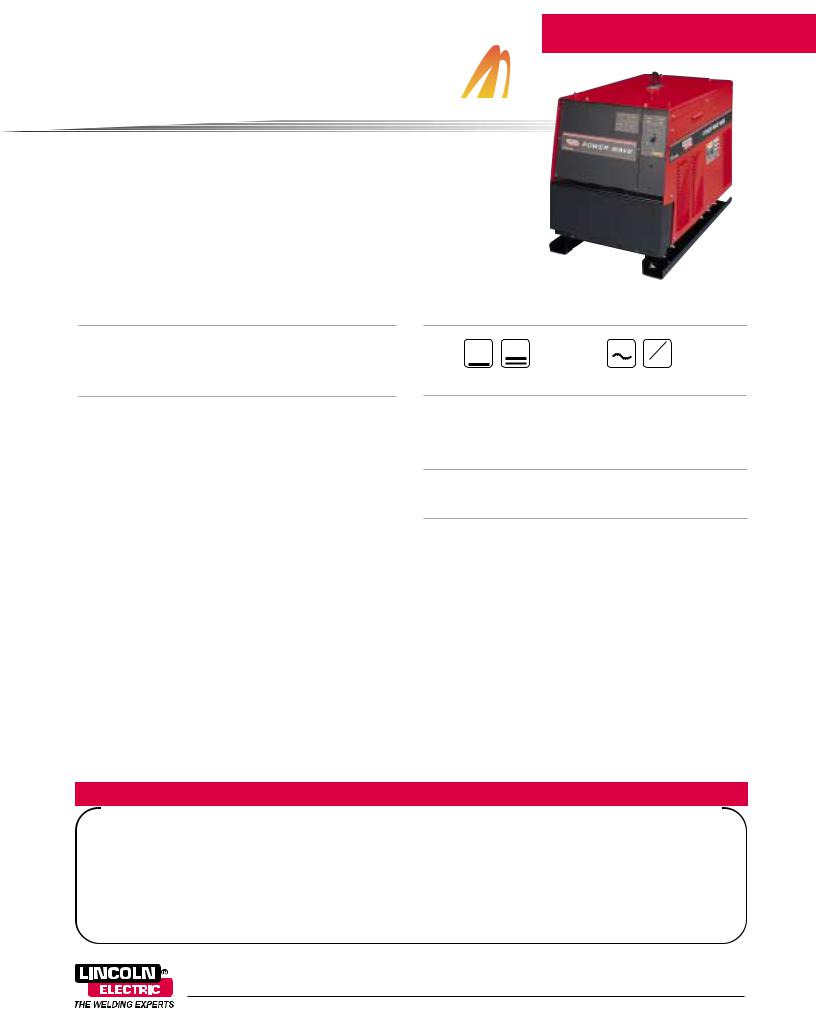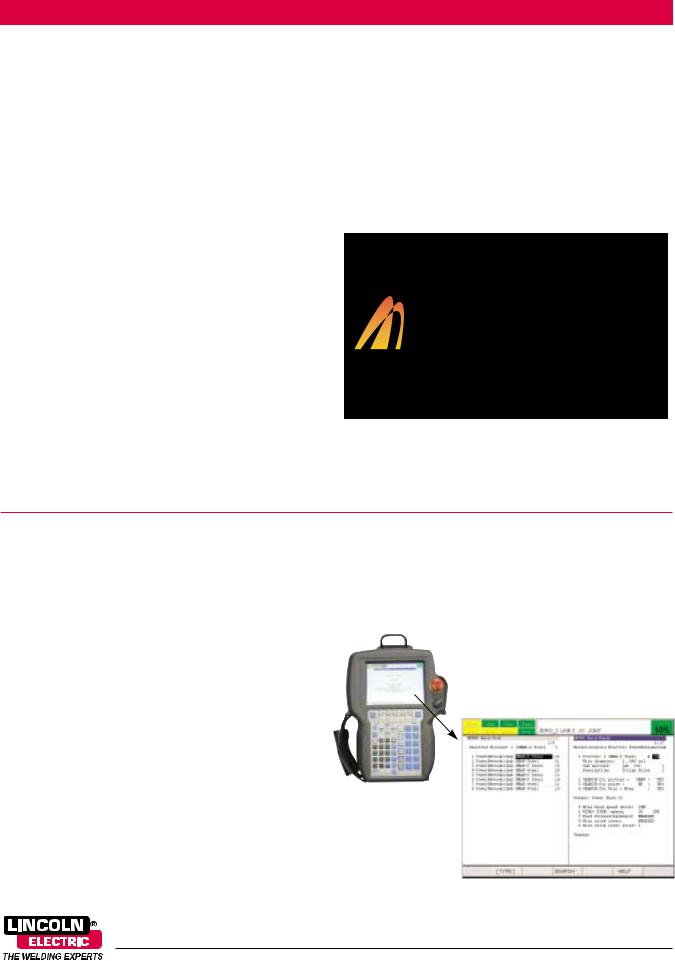Lincoln Electric Power Wave 455M Robotic, 455M-STT, POWER WAVE 455 M User Manual

AUTOMATED SOLUTIONS
Power Wave® 455M Robotic &
Power Wave® 455M/STT Robotic 




The Next Generation . . .
The Power Wave 455M Robotic is a high performance, digitally controlled inverter power source designed for robotic, hard automation and semiautomatic applications. It is designed to be part of a modular, multi-process welding system that can be arranged in a variety of ways for optimum, customized performance and easy maintenance. Optional DeviceNet™ and Ethernet communication modules provide networking capabilities and allow the power sources to communicate with other industrial machines to create a highly integrated and flexible welding cell. Available as a standard model or with Lincoln’s STT® process for applications in which heat input control, minimal distortion, reduced spatter and low fumes are essential.
Processes
MIG Pulsed STT Flux-Cored
Advantage Lincoln
•Program your own waveform or choose from over 60 standard welding waveform programs that offer a broad range of electrode size, type and shielding gas combinations to give you optimal appearance, penetration, beadshape and travel speed for each application.
•Modular design enables robotic, hard automation and semiautomatic applications using a single machine platform.
•Optional communication modules provide networking capabilities via DeviceNet or Ethernet.
•Utilizes ArcLink™ - the leading digital communication protocol for welding, making it the best choice for seamless, time critical integration to the power source and networked equipment.
•Software based controls can be upgraded as new features become available.
•Process and production monitoring with access to real time (500Hz) feedback such as arc current, voltage and wire feed speed. Access to internal data acquisition (10KHz) and access to real time machine status such as fault/alarm conditions and arc time.
•A Power Wave inverter operates at a high efficiency (88-90%) with a 95% minimum power factor(1) and is capable of operat-
ing from a universal input voltage (208 to 575 volts).
•Power Wave 455M/STT features Lincoln’s Surface Tension Transfer® Process, which controls heat input for great penetration and reduced spatter and fumes.
Description
Output |
CC |
DC |
Input 3 |
50 |
CV |
60 |
|||
|
|
|
PHASE |
Hz |
Recommended General Options
DeviceNet Interface Module, Ethernet Interface Module, Analog Interface Module, Wave Designer™ Software, Dual Cylinder Platform Undercarriage, CoolArc® 40 Water Cooler
Recommended Wire Feeder
Power Feed 10R
Order
K2262-1 Power Wave 455M Robotic
K2263-1 Power Wave 455M/STT Robotic
Call the Lincoln Electric Automation Division at 216.383.2667 for more information.
TECHNICAL SPECIFICATIONS
Product |
Product |
Input |
Rated Output |
Input current |
Output |
Dimensions |
Net |
|
Name |
Number |
Voltage |
Current/Voltage/Duty Cycle |
@Rated Output |
Range |
H x W x D |
Weight |
|
|
|
|
|
|
|
in. (mm) |
lbs. (kg) |
|
|
|
|
|
|
|
|
|
|
Power Wave 455M Robotic |
K2262-1 |
208/230/460/575/3/50/60 |
60Hz: |
60Hz: |
5-570A |
26.1 x 19.9 x 32.9 |
286 |
|
|
|
|
450A/38V/100% |
58/53/25/22A |
|
(663 x 505 x 835) |
(130) |
|
|
|
|
(570A/43V/60%) |
(82/78/37/31A) |
|
|
|
|
Power Wave 455M/STT Robotic |
K2263-1 |
|
50Hz: |
50Hz: |
|
|
293 |
|
|
|
|
400A/36V/100% |
49/45/23/18A |
|
|
(133) |
|
|
|
|
(500A/40V/60%) |
(67/61/31/25A) |
|
|
|
|
|
|
|
|
|
|
|
|
|
(1) At rated output.
Publication E10.90 4/03
www.lincolnelectric.com

A CLOSER LOOK
PERFORMANCE
•The Power Waves contains a large library of welding programs or “weld modes.” Each weld mode is a specific software program that defines the output characteristics of the power source for simple processes like Stick and TIG to more complex processes like Synergic MIG (GMAW) and Pulsed MIG (GMAW-P). Weld modes were developed to handle a broad range of applications. They may be tuned to a specific electrode type, electrode diameter,
gas type or application.
•All Power Waves share a common digital control platform to maximize interoperability, interchangeability and compatible software tools.
Nextweld
Lincoln's Power Wave power sources are equipped with Nextweld innovations that offer seamless system integration, high efficiency and reliability, and outstanding arc control. Here are just a few of Nextweld's technologies and processes that are standard with this machine.
•Waveform Control Technology™ controls and shapes the output waveform. Optimizes metal transfer to reduce spatter and improve stability. Simplifies process selection and controls heat input.
•Surface Tension Transfer (STT)(1) is a Waveform Control process that uses current controls to adjust the heat independent of wire feed speed, provides low heat input without overheating or burning through. Distortion, spatter and smoke are reduced.
•Power Wave Robotic Welding Systems feature weld mode selection, PRE-FLOW, RUN-IN, ARC CONTROL, BURNBACK, POST-FLOW and CRATER that provide the operators full control over the welding procedure and sequence.
•Synergic welding eliminates the need to independently set the wire feed speed and voltage. Synergic welding automatically sets both voltage and pulse characteristics based on the wire feed speed.
WHAT IS NEXTWELD™?
Nextweld incorporates Lincoln's technologies, processes and products to create a technologically advanced arc welding platform. Waveform Control Technology™, power electronics and digital communications provide the foundation for Nextweld innovations, including Surface Tension Transfer®, Pulse-On-Pulse™,  Chopper Technology™, ArcLink™ and many more. Try Nextweld products for ultimate arc control, high efficiency/reliability, and seamless system integration.
Chopper Technology™, ArcLink™ and many more. Try Nextweld products for ultimate arc control, high efficiency/reliability, and seamless system integration.
•The Power Wave 455 features Ethernet and DeviceNet compatibility, as well as ArcLink, the leading communication protocol for welding and the best choice for seamless, time critical integration to the power source and networked equipment.
•State-of-the-Art Inverter technology provides high power efficiency, excellent welding performance and a lightweight, compact design. Rigorous environmental, mechanical and weld testing ensures ruggedness and reliability.
FEATURES
•When connected to Fanuc robot, welding software is accessible via the Robot’s teach pendant or a computer via the RS232 serial port.
•Welding software is upgradable via the RS232 serial port or via a network using the optional Ethernet module.
•Add, customize or replace Lincoln updated welding waveforms for every application using a laptop and Lincoln’s Wave Designer Software.
Robot Teach Pendant
•Select from over 60 standard welding procedures in the power source library from the robot’s Teach Pendant.
•Search by process and wire type.
•Full access to all power source details, including: control loop gains, machine calibration, arc statistics, unfiltered feedback signals.
•Access to power source diagnostic such as fault/alarm status/details.
•ArcLink is a leading digital communications protocol for sharing information between intelligent components in an arc welding system.
•Individual status light for each system component.
•Simple, reliable input voltage changeover.
•Auto device recognition simplifies accessory cable connections.
•Individual status light for each system component.
•DeviceNet or Ethernet modules can be field installed.
FANUC Robot
Teach Pendant
Welding Software
(1) Power Wave 455M/STT only
Power Wave 455M Robotic and Power Wave 455M/STT Robotic
[2] |
www.lincolnelectric.com |

A CLOSER LOOK
Key Controls |
5 |
1
2
3
4
Power Wave 455M Robotic and 455M/STT Robotic Front Panel.
1.Thermal Light
2.Power Supply Status Light
3.On/Off Switch
4.Optional Communication Module Status Light (DeviceNet or Ethernet)
5.Feeder Status Light
1. Communication Interface Module -
DeviceNet or Ethernet/DeviceNet upgrades can be field installed.
1
Power Wave 455M Robotic and 455M/STT Robotic Front Panel.
1 |
2 |
3 |
4 |
|
|
|
|
|
|
||||||
|
|
|
|
|
|
|
|
|
|
|
|
|
|
1. |
Devicenet or Ethernet/DeviceNet Receptacle (optional) |
|
|
|
|
|
|
|
|
|
|
|
|
|
|
2. |
ArcLink Receptacle |
|
|
|
|
|
|
|
|
|
|
|
|
|
|
3. |
Work Sense Lead Receptacle |
|
|
|
|
|
|
|
|
|
|
|
|
|
|
4. |
RS-232 Diagnostic Receptacle |
|
|
|
|
|
|
|
|
|
|
|
|
|
|
||
|
|
|
|
|
|
|
|
|
|
|
|
5 |
5. |
External Input Connector |
|
|
|
|
|
|
|
|
|
|
|
|
|||||
|
|
|
|
|
|
|
|
|
|
|
|
6 |
|
6. |
STT Stud (not shown) |
|
|
|
|
|
|
|
|
|
|
|
7. |
Positive Output Stud |
|||
|
|
|
|
|
|
|
|
|
|
|
|
|
|
||
11 |
|
|
|
|
|
|
|
7 |
8. |
CB1 (10A) 40VDC |
|||||
|
|
|
|
|
|
|
|
|
|
|
|
|
|
9. |
115VAC Receptacle |
|
|
|
|
|
|
|
|
|
|
|
|
|
|
10. |
CB1 (10A) 40VDC |
|
|
|
|
|
|
|
|
|
|
|
|
|
|
11. |
Negative Output Stud |
10 |
|
|
|
9 |
|
8 |
|
|
|
|
|
||||
|
|
|
|
Front Lower Panel |
|
|
|||||||||
|
|
|
|
|
|
|
|
|
|
|
|
|
|
|
|
|
|
|
|
|
|
|
|
|
|
|
|
|
|
|
|
Power Wave 455M Robotic and Power Wave 455M/STT Robotic
[3] |
www.lincolnelectric.com |
